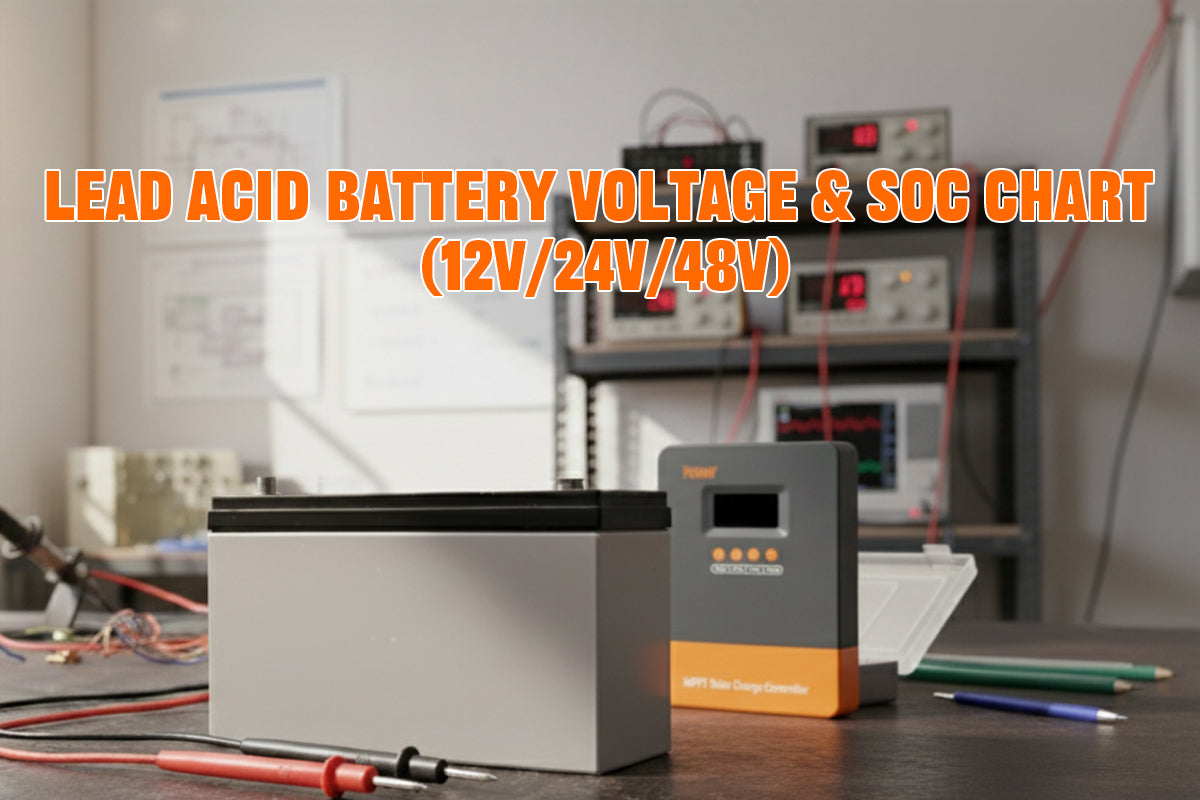Compared to LiFePO4 batterie, lead-acid charging is more complicated, involving three or four stages (Bulk, Absorption, Float, and Equalization), and it carries a higher risk of overcharging than LiFePO4. Overcharging can cause gassing, water loss, and grid corrosion.
That’s why it is essential to strictly monitor the state of charge lead-acid batteries according to their voltage and capacity. In this article, we provide a lead-acid battery voltage chart, covering different types (Flooded, AGM, and Gel) and 12 V, 24 V, and 48 V systems, while illustrating how it tells the battery’s available capacity (SOC), along with additional expert tips for checking it.
Related Article:
Lead acid battery cell voltage
By connecting a specific number of cells in series, a battery can be configured to meet the voltage standards of different DC systems.
Lead acid battery can be divide into two groups: Flooded lead acid battery(FLD) and sealed lead acid battery(SLD/SLA), and the latter has Gel battery and AGM battery.
The nominal cell voltage of lead acid battery is 2V, stabilizing at about 2.1V to 2.15V when fully charged and at rest.
What is lead acid battery voltage vs capacity chart
It may sound puzzling to a beginner, but a battery can have a voltage higher than its rated voltage. Because true voltage is a dynamic reading based on its charge level or state of charge (SOC).
As a rule of thumb, lead acid battery voltage drops slowly from 100% down to 50% SOC. However, below 50% SOC, the voltage plummets rapidly. If you keep it discharging further, it may cause internal damage known as sulfation, accelerate aging, or even permanently destroy kill the battery.
Therefore, a lead acid battery voltage vs capacity chart is crucial for clearly identifying the SOC and helping user to adapt corrsponde actions to protect the battery and maximize its lifespan.
Here is a chart showing the relationship between the State of Charge and the at-rest voltage of a single lead-acid cell.

To determine the voltage for a complete battery, multiply the fundamental voltage by the number of cells. The following charts provide these calculated values for 12V (6 cells), 24V (12 cells), and 48V (24 cells) systems.
Lead acid battery voltage chart
The voltage charts below are provided for general refering. Due to slight differences in chemistry and construction between manufacturers, the most accurate data is from your specific brand, please always prioritize the datasheet or manual that came with your lead acid battery, as it is the definitive source of truth for your equipment.
12V lead acid battery voltage chart

24V lead acid battery voltage chart

48V lead acid battery voltage chart

How to check lead acid battery charged level?
Knowing the voltage charts is the first step. The next is to as accurately as possible measure your battery's voltage to determine its SOC. Here are the two simple and intuitive methods, from most common to most accurate.
1. Using a multimeter
Resting voltage is the most stable indicator of state of charge for lead-acid battery, but under load or after charging, the voltages will differ.
- So, to check the voltage of lead acid battery, firstly disconnect the battery from all charging sources and loads.
- Then, the battery must be left to rest for at least 4 hours, but 8 to 12 hours is more recommendationed. This allows the charge generated on the surface of the battery plates during recent charging to dissipate, enabling the voltage to return to a stable state and thereby providing a more accurate reading.
- Set a quality digital multimeter to the DC Voltage setting. Touch the red probe and black probe respectly to the positive terminal and negative (-) terminal.
- Take the voltage reading and compare it to the lead acid battery voltage vs SOC chart (12V, 24V, or 48V, and your battery type).
2. Using a shunt-based battery monitor
This is the gold standard for real-time battery monitoring, especially in systems that are constantly in use, like in an RV or off-grid home.
- A device called a shunt is installed on the main negative cable of the battery bank.
- This shunt precisely measures every amp-hour of energy going into and out of the battery.
- The monitor uses this data to "count" the energy and provides a highly accurate, real-time SOC percentage on a display screen, without needing the battery to be at rest. It's like having a fuel gauge for your battery bank.
FAQs on lead acid battery voltage chart
What is the normal voltage of a lead acid battery?
A fully charged 12V lead acid battery typically reads 12.6V to 12.8V at rest. When charging, it can reach 13.8V–14.4V, and it's considered fully discharged when it drops to around 11.9V–12.0V, depending on the battery type, charger and stage.
What voltage is 50% of a 12V battery?
A 50% state of charge (SOC) for a 12V lead acid battery corresponds to approximately 12.2V when measured at rest. It’s best not to regularly discharge below 50% to extend the battery’s lifespan.
Why is my fully charged lead acid battery reading only 12.7V or 12.8V, not the 13.0V+ the chart shows for 100%?
A voltage of 12.7–12.8V actually indicates a full charge for most flooded, AGM, and Gel lead acid batteries at rest. Charts showing 13.0V or more often reflect the surface charge immediately after charging, not the stabilized resting voltage.


